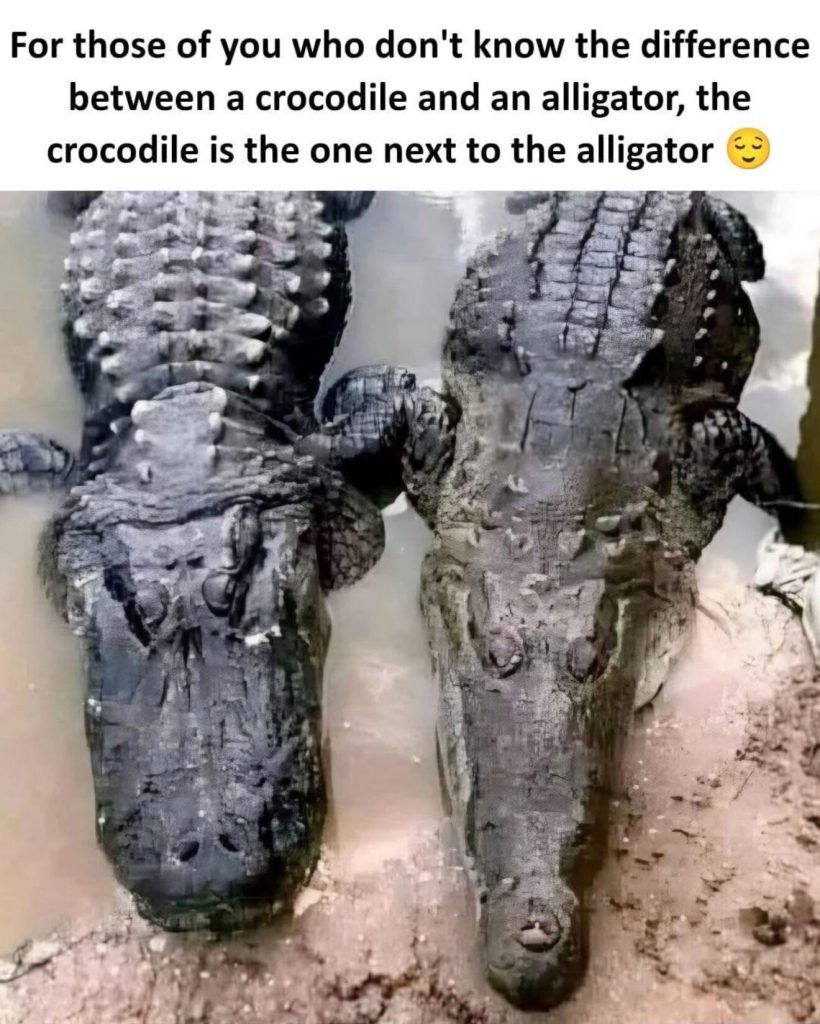Have you ever stared at a picture of an alligator and a crocodile side by side and thought, “Well… they both look like toothy dinosaurs, so… what’s the difference?” If that sounds like you, welcome to the club! This photo challenge has been making people scratch their heads, second-guess themselves, and even start heated debates in the comments section.
Today, I’m giving you the ultimate breakdown—not just to help you solve THIS puzzle, but so you’ll never be fooled again. Ready to put your wildlife detective skills to the test?

Why This Puzzle Trips People Up
The biggest reason so many people get this wrong is simple: our brains love shortcuts. We see two scaly reptiles in murky water, and boom—our minds file them under “basically the same thing.” Add in similar body shapes, textures, and colors, and suddenly the differences blur together.
Another factor? The details that set them apart are subtle. They’re not wearing name tags. The cues are in their snouts, teeth, and even the way they sit in the water—and unless you’ve been on a swamp tour or watched a dozen nature documentaries, those differences aren’t second nature.
Plus, let’s be honest—sometimes people just guess. And when they guess, they tend to go for the wrong one.
The Most Common Mistakes People Make
- Judging Only by Size
Many think the bigger one must be the crocodile. While crocodiles can grow larger, this isn’t a reliable way to tell. Young crocodiles can be smaller than adult alligators. - Assuming Skin Color Will Be Obvious
The color difference is real, but lighting, mud, and water all affect how they look. In photos, both can appear dark or washed out. - Forgetting About the Teeth
This is a huge giveaway, but you need a close look. Crocodiles’ lower teeth stick out even when their mouths are closed, while an alligator’s tend to stay hidden.
Video : #memes #meme #memesdaily
How to Solve the Alligator vs. Crocodile Puzzle—Step by Step
Step 1: Look at the Snout Shape
- Alligator = U-shaped snout. It’s wider and more rounded at the tip.
- Crocodile = V-shaped snout. It’s longer and more pointed, almost like a narrow arrowhead.
In the photo, notice how the animal on the left has a broad, rounded snout—that’s your alligator. The one on the right has a thinner, pointed snout—that’s your crocodile.
Step 2: Check the Teeth
If you can see their teeth while their mouths are closed, you’re probably looking at a crocodile. Alligators hide theirs.
Step 3: Notice the Color Tone
Alligators tend to have darker, almost black-gray skin—especially when living in freshwater swamps. Crocodiles often have a lighter, olive-green or tan tint.
Step 4: Think About Their Habitat
While you can’t tell from the photo, knowing where the picture was taken can help. If it’s in Florida, both live there—but crocodiles stick to coastal, brackish water, while alligators prefer fresh water.

The Correct Answer for This Puzzle
In this specific photo:
- Left = Alligator (broad U-shaped snout, darker tone)
- Right = Crocodile (narrow V-shaped snout, slightly lighter tone)
Once you see it, you can’t unsee it. And from now on, your brain will spot those subtle clues much faster.
Why This Knowledge Is Actually Useful
This isn’t just a fun internet game—it’s a survival tip. If you ever find yourself near one of these reptiles, knowing which is which can help you predict their behavior. Alligators tend to be less aggressive toward humans (though you should never approach either), while crocodiles can be more territorial and dangerous.
Plus, impressing your friends during trivia night or on a wildlife tour? That’s a bonus.
A Quick Memory Hack
Here’s how to lock it into your brain:
- U-shaped snout → Alligator (think “U” for “United States,” where most alligators live).
- V-shaped snout → Vicious Crocodile (crocodiles are generally more aggressive).
Video : Who is the fake doctor ?
Your Turn—Test Yourself and Share!
Now that you know the trick, it’s your turn to join the fun:
- Drop your guess (before you read the answer!) in the comments.
- Share this with a friend and see if they can spot the difference.
- Try finding more side-by-side photos online and see how fast you can identify them.
The more you practice, the faster you’ll get—and before long, you’ll be that person confidently saying, “That’s not just a crocodile, that’s a Nile Crocodile.”
Final Thought
In a world full of lookalikes, the details matter. Whether it’s reptiles, cars, or coffee beans, the ability to slow down, observe, and notice subtle differences is a skill worth sharpening.
So next time you see a photo like this, don’t just scroll past—pause, analyze, and make your call. Who knows? You might just be in that 1% who gets it right every time.